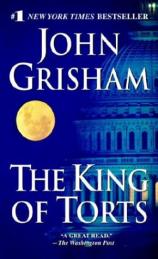The King of Torts
Review
The King of Torts
Mention the name "John Grisham" to most readers and the image of a
courtroom populated by two lawyers, one honest and one corrupt,
quickly comes to mind. That image may not, however, be completely
correct. Since his appearance as a novelist in 1991, Grisham has
annually produced a best-selling work. In those efforts, he wanders
in and out of the courtroom and spends a great deal of time away
from the law. While his major characters are often attorneys, they
frequently find themselves in predicaments that bear only an
incidental connection to the legal profession. Previous Grisham
efforts such as THE FIRM, THE BRETHREN and, to a degree, THE
PELICAN BRIEF and THE SUMMONS, represent plot lines in which the
main characters could easily be non-lawyers without significant
impact on the narrative.
Whether one considers Grisham a courtroom or mystery writer, it is
clear in his writing that, as a former practicing attorney, he has
much to offer about the strengths and failings of the American
legal system. In his books, Grisham has taken to task politically
motivated prosecutors, the flawed juvenile justice system, the
health insurance and tobacco industries and insurance defense
attorneys. Last year, in THE SUMMONS, Grisham had some unkind words
for those members of the legal profession often pejoratively
referred to as "trial lawyers". Now, in THE KING OF TORTS, Grisham
returns to this subject and sets his sights on that particular
aspect of trial law very much in discussion today --- the field of
mass tort litigation.
THE KING OF TORTS follows the winning Grisham formula. Early in the
novel, an insignificant crime of violence introduces us to Jarrett
Clay Carter II. Young Carter is an overworked, underpaid and
under-appreciated public defender in the District of Columbia. He
is appointed to represent Tequila Watson, a career drug offender
charged with the murder of Ramon "Pumpkin" Pumphrey. Like many of
Grisham's young lawyer heroes, Clay Carter is at the juncture of
his life when he has begun to question his status in the legal
system.
THE KING OF TORTS is the Faustian tale of Carter's meteoric rise to
the top of the field of mass tort litigation. Shortly after his
appointment to represent Watson, Max Pace, a man of mystery and
intrigue, visits Carter. He offers the young attorney the
opportunity to initiate litigation against a drug manufacturer who
has negligently produced a product that causes people to kill.
Although Clay Carter has countless questions and concerns, Pace's
simple answer is always to remind him of the millions of dollars in
legal fees that will soon be deposited in the accounts of the new
law firm that Carter will control. That answer is sufficient.
In the span of several months, Carter becomes the beneficiary of
nearly $100 million in fees. Such an achievement is most ironic
when one considers that never during the course of his spectacular
achievement does Carter even enter a courtroom. Indeed, his only
venture inside a courthouse during the course of this novel occurs
when Carter watches one of his fellow attorneys attempt to win a
case that will produce millions of dollars in fees for Carter and
his firm.
In his meteoric rise, Clay Carter becomes a member of an exclusive
club of trial attorneys who engage in mass tort litigation, often
referred to as class actions. In these types of cases, thousands of
injured parties are grouped together to bring their claims.
Oftentimes, small claims in the range of $25,000 to $50,000 are
bundled together. The main beneficiaries of such activity are the
attorneys who generate large legal fees from settlements in
thousands of cases without being forced to handle each case on an
individual basis. Attorneys in this field often obtain clients by
advertisements in newspapers, radio and television. Because
successful mass tort lawyers obtain their cash awards from huge
corporations, the entire subject has become a high stakes political
contest between the business and legal communities.
The major character in THE KING OF TORTS is not Clay Carter.
Rather, the attorneys who engage in mass tort litigation are the
prime targets for Grisham's wrath. As they fly around the country
ferreting out clients like bloodhounds hunting down criminals,
Grisham enjoys poking fun at their numerous foibles. They are far
more interested in fancy private jets, beautiful women, vintage
wine and high-class living than in securing justice. John Grisham,
a man who practiced law for several years before commencing his
writing career, does not find such characters to be an asset to the
legal profession.
THE KING OF TORTS is a prime example of the adage that, in novels,
"Plot trumps the truth." In order to make the novel work, Grisham
must compress a great deal of action into a short amount of time.
Anyone with a minimal knowledge of the workings of the American
legal system knows that what John Grisham has written is
hyperbolic. But Grisham has written with a message. The debate in
America today over "tort reform" and the "malpractice crisis" is
continuing and clamorous. Although it is a work of fiction, THE
KING OF TORTS can help enhance the quality of that debate. Anyone
interested in the issue, or just interested in another appealing
novel, will enjoy John Grisham's latest effort.
Reviewed by Stuart Shiffman on January 22, 2011





